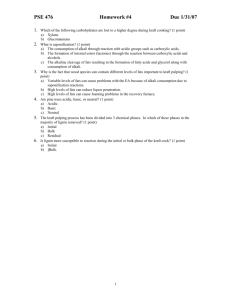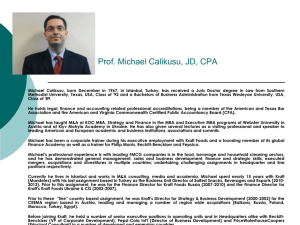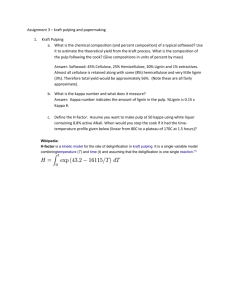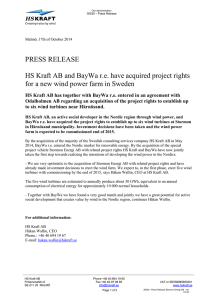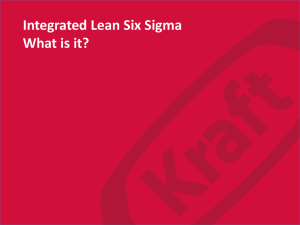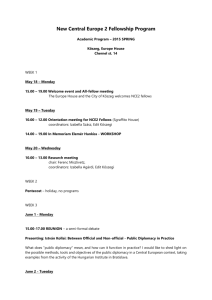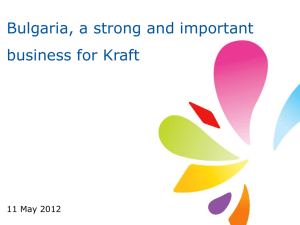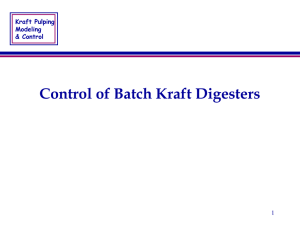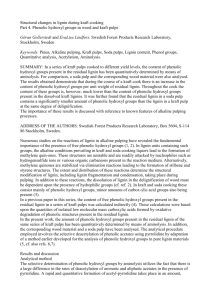Study Guide
advertisement
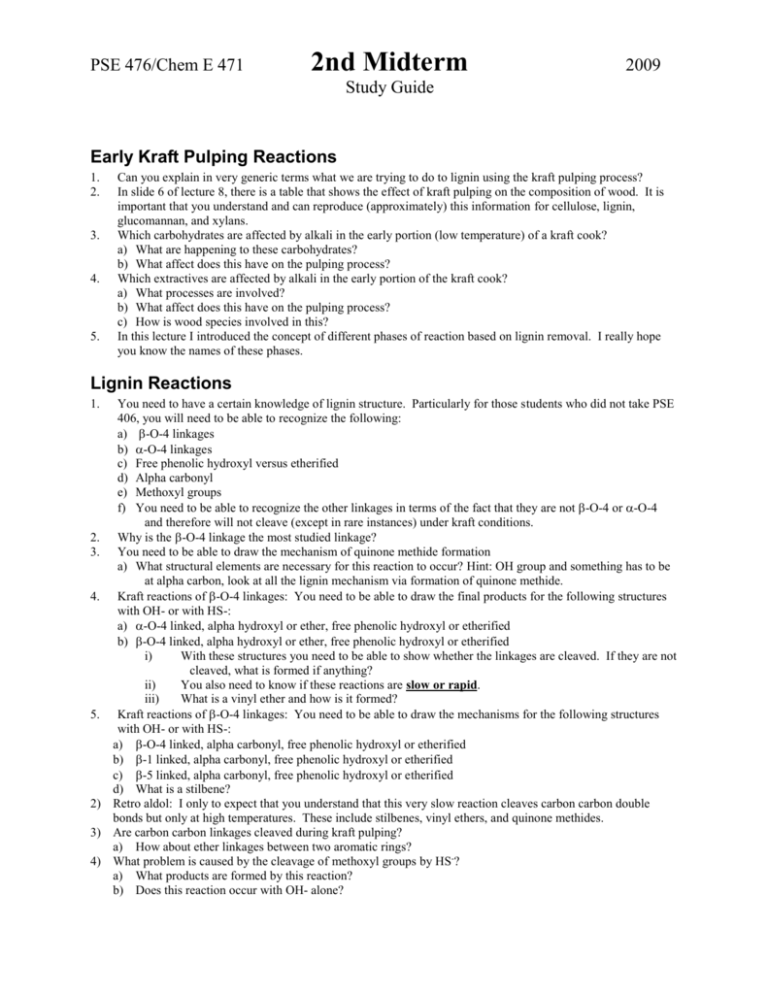
PSE 476/Chem E 471 2nd Midterm 2009 Study Guide Early Kraft Pulping Reactions 1. 2. 3. 4. 5. Can you explain in very generic terms what we are trying to do to lignin using the kraft pulping process? In slide 6 of lecture 8, there is a table that shows the effect of kraft pulping on the composition of wood. It is important that you understand and can reproduce (approximately) this information for cellulose, lignin, glucomannan, and xylans. Which carbohydrates are affected by alkali in the early portion (low temperature) of a kraft cook? a) What are happening to these carbohydrates? b) What affect does this have on the pulping process? Which extractives are affected by alkali in the early portion of the kraft cook? a) What processes are involved? b) What affect does this have on the pulping process? c) How is wood species involved in this? In this lecture I introduced the concept of different phases of reaction based on lignin removal. I really hope you know the names of these phases. Lignin Reactions 1. You need to have a certain knowledge of lignin structure. Particularly for those students who did not take PSE 406, you will need to be able to recognize the following: a) -O-4 linkages b) -O-4 linkages c) Free phenolic hydroxyl versus etherified d) Alpha carbonyl e) Methoxyl groups f) You need to be able to recognize the other linkages in terms of the fact that they are not -O-4 or -O-4 and therefore will not cleave (except in rare instances) under kraft conditions. 2. Why is the -O-4 linkage the most studied linkage? 3. You need to be able to draw the mechanism of quinone methide formation a) What structural elements are necessary for this reaction to occur? Hint: OH group and something has to be at alpha carbon, look at all the lignin mechanism via formation of quinone methide. 4. Kraft reactions of -O-4 linkages: You need to be able to draw the final products for the following structures with OH- or with HS-: a) -O-4 linked, alpha hydroxyl or ether, free phenolic hydroxyl or etherified b) -O-4 linked, alpha hydroxyl or ether, free phenolic hydroxyl or etherified i) With these structures you need to be able to show whether the linkages are cleaved. If they are not cleaved, what is formed if anything? ii) You also need to know if these reactions are slow or rapid. iii) What is a vinyl ether and how is it formed? 5. Kraft reactions of -O-4 linkages: You need to be able to draw the mechanisms for the following structures with OH- or with HS-: a) -O-4 linked, alpha carbonyl, free phenolic hydroxyl or etherified b) -1 linked, alpha carbonyl, free phenolic hydroxyl or etherified c) -5 linked, alpha carbonyl, free phenolic hydroxyl or etherified d) What is a stilbene? 2) Retro aldol: I only to expect that you understand that this very slow reaction cleaves carbon carbon double bonds but only at high temperatures. These include stilbenes, vinyl ethers, and quinone methides. 3) Are carbon carbon linkages cleaved during kraft pulping? a) How about ether linkages between two aromatic rings? 4) What problem is caused by the cleavage of methoxyl groups by HS-? a) What products are formed by this reaction? b) Does this reaction occur with OH- alone? PSE 476/Chem E 471 2nd Midterm 2009 Study Guide 5) Lignin carbohydrate complexes a) It is known that there are linkages between lignin and hemicelluloses in wood and that these linkages can retard the removal of lignin. Which of the following are cleaved during kraft pulping? i) Ester linkages ii) Glycosidic linkages iii) Ether linkages (on rings with free or etherified phenolic hydroxyls) 6) Condensation reactions: a) You will need to understand the basic mechanism involved here. If I were to give you 2 phenolic compounds, you need to be able to show me the condensation products. i) There are 3 possibilities: (1) Formation of -1 (requires side chain displacement) (2) Formation of -5 (3) Formation of diphenyl methane (reaction with formaldehyde) b) Can you show which structures from lignin will act as nucleophiles? Kraft Carbohydrate Reactions 1. 2. 3. 4. Carbohydrate reactions a) In general terms what is the peeling reaction? i) Where does it occur? ii) What causes this reaction? iii) At what temperature does it start? iv) What is formed? v) Is this a good or bad reaction? vi) I know it is really terrible of me but you need to know the steps in the mechanism. b) What is the stopping reaction? i) Where does it occur? ii) What causes this reaction? iii) At what temperature does it start? iv) What is formed? v) Is this a good or bad reaction? vi) I know it is really terrible of me again but you need to know the steps in the mechanism. c) What is glycosidic cleavage? i) At what point in a carbohydrate does this reaction occur? a) What are the products of this reaction? b) Is this reaction more of a problem for cellulose or hemicelluloses? c) You do not need to know this mechanism. d) What happens to acetate groups on hemicelluloses during kraft pulping? Glucomannans a) Can you describe what happens to the glucomannans during a kraft cook i) % lost ii) Reaction pathways iii) Effect of EA Xylans a) Can you describe what happens to the glucomannans during a kraft cook i) % lost ii) Reaction pathways iii) Effect of EA iv) Can you draw a hexenuronic acid? Why are these structures important? v) Why don't xylans peel as fast as the other carbohydrates? What affect does temperature have on the processes involved with xylans? Cellulose a) What reactions does cellulose undergo during kraft pulping? PSE 476/Chem E 471 2nd Midterm 2009 Study Guide i) ii) Which of these reactions is most important to cellulose loss? Why? What do these reaction have to do with pulp strength? Kraft Pulping Kinetics 1. In this lecture, we covered the effect on system variables (some variables) on pulping rate and product quality (a little bit). a) Wood species: In general, do hardwoods or softwoods pulp easier? b) How does the EA charge affect rate and amount of delignification? i) Which method of increasing EA has more effect: increasing the amount of liquor or changing the concentration of NaOH in the liquor? c) Does increasing EA have more effect on lignin removal in the initial or bulk phase? d) What effect does increasing EA have on pulp properties? e) Do changes in EA affect glucomannan removal? f) Do changes in EA affect xylan removal? g) What effect does increasing sulfididty have on delignification? i) Is this affect more pronounced in the initial or bulk deligninfication phase? Why? H Factor 1. I don't expect you to be able to derive the H factor equation but I do expect you to be able to: a) Describe what relative reaction rate means i) Describe the effect of temperature on relative reaction rate b) H factor i) What does it exactly mean? ii) How is it determined? The Kraft Recovery Process 1. 2. 3. 4. 5. On slide 3 of lecture 15 there is a schematic of the kraft recovery process. I would hope that you could explain how each step listed works. Liquors a) You need to know general compositions of white, black, and green liquors in terms of what are the major components in each. I don't expect numbers just lots of this and a little of that. Evaporators The furnace: a) What are the 2 basic functions of a recovery furnace? b) Can you describe what happens to the black liquor after it is added to the recovery furnace? i) How is carbonate formed? ii) How are sulfates converted to sulfides? c) What is the smelt? Caustizing a) What is caustizing? b) What is slaking? c) What reactions go on during causticizing? d) What is the lime kiln used for?
